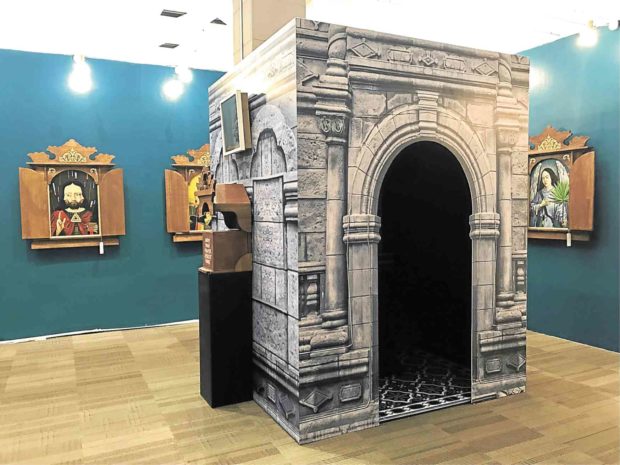
Artist Wilfredo Offemaria Jr. has reinterpreted his previous series of art installations—on the urna and retablo—in his exhibit, “Visita,” mounted by the Artery Manila during ManilART 2018 recently.
The title refers to the “mission chapels” of old, sub-parish churches or communities that were in the process of becoming full-fledged parishes. It likewise refers to the Maundy Thursday practice in which families and devotees visit churches in imitation of Christ making his way to Calvary and his passion and crucifixion.
Last year, Offemaria reimagined the retablo—the grand receptacle of religious imagery that works as backdrop to the Eucharist and other sacraments performed in a church. An installation, Stations of the Cross, had the familiar figures made to converse (Offemaria is better known as an abstractionist) with the abstract paintings surrounding them; they were arranged in a way that the exhibition space resembled a chapel. The same installations are reinterpreted in “Visita,” yet the stations and the chapel are smaller in size, perhaps attributing to the scale of the mission chapels.
Early this year, Offemaria refigured the urna—similarly a receptacle of religious imagery, but smaller in scale and often used in intimate domestic spaces. The urna were bare of their detailed elaborations to highlight the gestures that they fundamentally perform—that of exhibiting, of framing, and of upstaging. Attaching itself onto the tradition, the exhibition centered on the figures depicted within the receptacles themselves, particularly the ideas they put forward, and the insights that the viewers gathered in and through them.
Commercialism
In both “Urna” and “Visita,” Offemaria playfully tackled commercialism and pop culture as contemporary idolatries. Through juxtaposing religious imageries with commercial brands and popular icons, the artist hoped to ignite curiosity from the viewers, especially the younger generations, to look more closely and engage with the images. Such is still evident in this exhibition.
In “Three in One,” the artist renders the Trinitarian face wearing a fashionable plaid undershirt; he has replaced the globus cruciger with a bottle of wine, and on the chest, there’s a logo of a popular streetwear brand as an emblem. The logo’s three-sided equilateral shape hints not only at the Trinity, but also at the stability and equality between the three. The commercial logo appears to enhance the image of the Holy Trinity. In “Crowned,” the King of Heaven and Earth is adorned with the five-pointed coronet of the king of watches. The brand’s slogan “A Crown for Every Achievement,” appears to reinforce comically the idea of rewarding accomplishments—the greatest of which was saving humanity from sin. In “Agony of a Superman,” Jesus is clothed with the colors of the famous pop superhero.
All of this shows Offemaria’s questioning contemporary idolatries, particularly commercialism.
In “Visita,” Offemaria recalls his beginnings and projects his continuances as he furthers his engagement with the Catholic religion, its history, and the metaphors and traditions that surround it, contributing to the dialogue on faith, heritage, and art in a post-colonial and post-industrial present. –CONTRIBUTED
“Visita” by Wilfredo Offemaria Jr. is presented by the Artery Manila and Art Assembly. E-mail arterymanila@gmail.com.